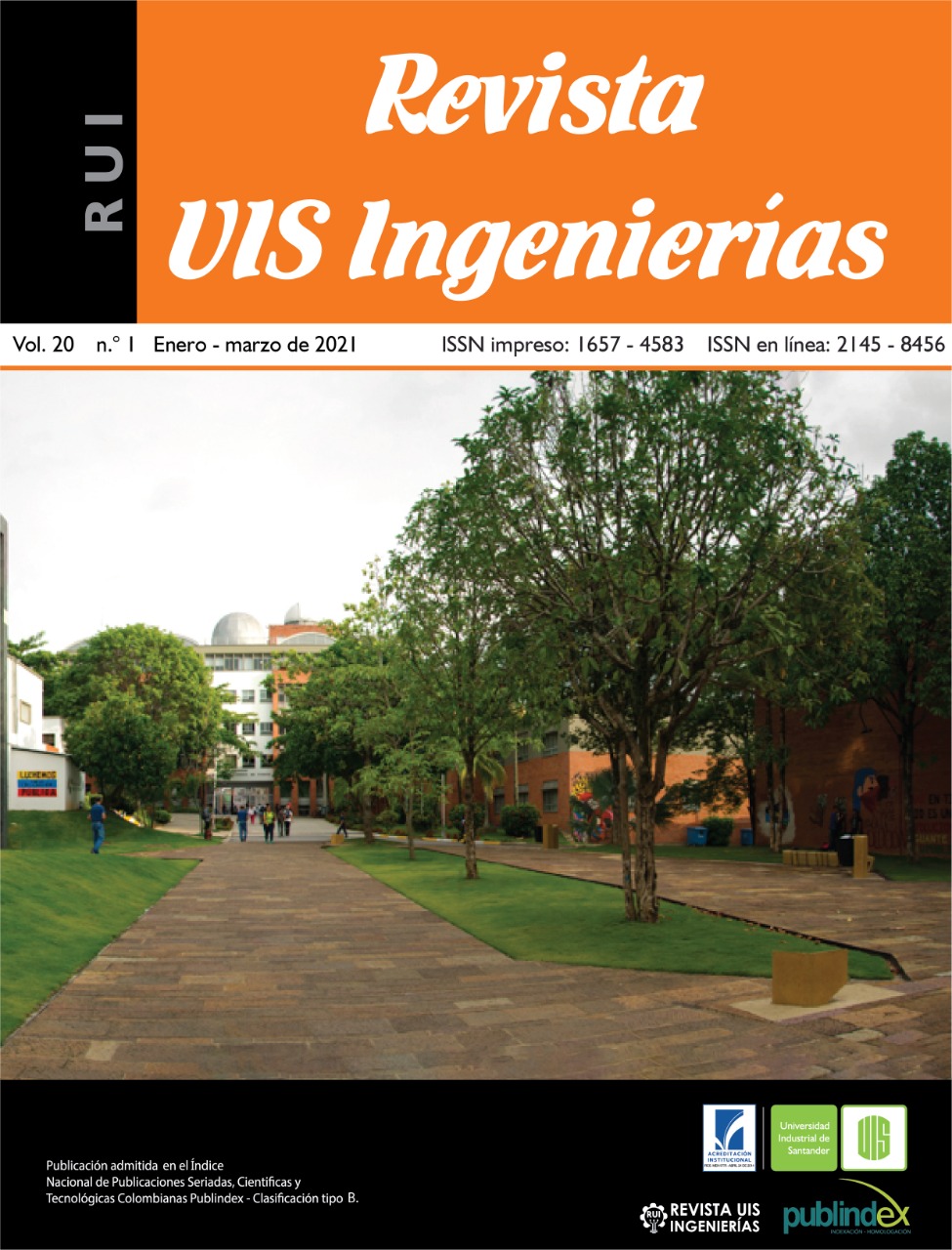Stochastic modeling of the evolution of highly contagious virus transmission in crowded places
Published 2020-11-03
Keywords
- virus transmission,
- contagion,
- social distancing,
- crowd,
- algorithm
- stochastic behavior,
- mathematical modeling,
- health authority,
- biosecurity protocols,
- numerical experiments,
- SARS-COv-2,
- COVID 19 ...More
How to Cite
Copyright (c) 2020 Revista UIS Ingenierías

This work is licensed under a Creative Commons Attribution-NoDerivatives 4.0 International License.
Abstract
A mathematical model is proposed for stochastic estimation of the number of the SARS-COv-2 virus infected person in places where there is a high concentration of population, such as shopping centers or other closed spaces. The aim is to obtain a mathematical model of virus propagation in closed spaces calculating the number of infected depending on compliance or violation of safe distances and compliance with protection standards, as well as a heuristic algorithm for their solution. Mathematical modeling was used to research the virus transmission situation and to develop a heuristic algorithm for the solution of the obtained mathematical model. The programming, the numerical experiments and the figures were constrained in MATLAB. The numerical experiments obtained for some cases show the dependence between the number of new infected with non-compliance of the recommendations for social distancing and the use of personal protection elements. The model is open to additions and improvements and may be of interest to support the decisions making process of the health and administrative authorities. The algorithm solves the proposed mathematical model to track virus transmission when the recommended safe and secure distances are not fulfilled. The application of the algorithm allows to propose controls in complex and unpredictable situations of epidemic development in population concentrations, so it can be used to improve the quality of proactive medical measures and other related decisions.
Downloads
References
[2] T. Lupia, S. Scabini, S. M. Pinna, G. Di Perri, F. G. De Rosa, S. Corcione, “2019-novel coronavirus outbreak: A new challenge,” Journal of Global Antimicrobial Resistance, vol. 21, pp. 22-27, doi: 10.1016/j.jgar.2020.02.021
[3] B. Ivorra, M. R. Ferrández, M. Vela-Pérez, A.M. Ramos, “Mathematical modeling of the spread of the coronavirus disease 2019 (COVID-19) taking into account the undetected infections. The case of China,” Communications in nonlinear science and numerical simulation, vol. 88, 2020, doi: 10.1016/j.cnsns.2020.105303
[4] T. Pueyo, “Coronavirus: Por qué Debemos Actuar Ya,” 2020, [En línea]. Disponible en:https://medium.com/tomas-pueyo/coronavirus-por-qu%C3%A9-debemos-actuar-ya-93079c61e200
[5] E. N. Nikolaev, , M.I. Indeykina, A.G. Brzhozovskiy, A.E. Bugrova, A. Kononikhin, N.L. Starodubtseva, G.T. Sukhikh, “Mass Spectrometric detection of SARS-CoV-2 virus in scrapings of the epithelium of the nasopharynx of infected patients via Nucleocapsid N protein,” Journal of Proteome Research, 2020, doi: 10.1021/acs.jproteome.0c00412
[6] Resolution of the Chief Sanitary Doctor of the Russian Federation N9 of 30.03.2020. On additional measures to prevent the spread of COVID-2019. [En línea]. Disponible en: https://www.rospotrebnadzor.ru/documents/details.php?ELEMENT_ID=14155
[7] B. Blocken,et al., “Towards aerodynamically equivalent COVID19 1.5 m social distancing for walking and running,” [En línea]. Disponible en: http://www.urbanphysics.net/COVID19_Aero_Paper.pdf
[8] Z. Yang, Z. Zeng, K. Wang, S.S. Wong, W. Liang, M. Zanin, J. Liang, et al., “Modified SEIR and AI prediction of the epidemics trend of COVID-19 in China under public health interventions,” Journal of Thoracic Disease, vol. 12, no. 3, 2020, doi: 10.21037/jtd.2020.02.64
[9] S. He, Y. Peng, K. Sun, “SEIR modeling of the COVID-19 and its dynamics,” Nonlinear Dynamics, vol. 101, no. 3, pp. 1667–1680, 2020, doi: 10.1007/s11071-020-05743-y
[10] L. Peng, W. Yang, D. Zhang, C. Zhuge, L. Hong, “Epidemic analysis of COVID-19 in China by dynamical modeling,” medRxiv, 2020, doi: 10.1101/2020.02.16.20023465
[11] R. M. Batalin, V. A. Terletskiy, “Optimal control in models of epidemics of vector-borne diseases with SEI-SEIR systems,” Bulletin of Irkutsk State University. Serie: Mathematics, vol. 14, pp. 18-30, 2015.
[12] S. Ilyin, “Coronavirus infection: modeling and prognosis,” Institute of Petrochemical Synthesis. A.V. Topchiev RAS. [En línea]. Disponible en: https://www.kommersant.ru/doc/4322667
[13] “nCovForecast: Forecasting tool code nCov (aplication Shiny)”. [En línea]. Disponible en: https://github.com/benflips/nCovForecast
[14] F. H. Lee, “A Heuristic Model for Spreading of COVID 19 in Singapore,” medRxiv, 2020, doi: 10.1101/2020.04.15.20067264
[15] N. Bacaer, “Modèle mathématique de l'émergence de l'épidémie de coronavirus en France. Institut de Recherche pour le Developpement,” Math. Model. Nat. Phenom., vol. 15, 2020, doi: 10.1051/mmnp/2020015

